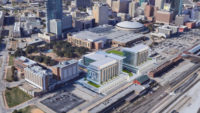New designs were unveiled April 27 for three bridges that will become an integral part of Fort Worth’s Trinity River Vision project, an urban waterfront plan to connect 88 mi of the Trinity River and its surrounding communities. The project planners hope to save some $45 million through the redesign.
The new scaled-back design featuring V-shaped piers was presented by TRV officials. The city of Fort Worth worked with the design team to present a citizen advisory group with design options that were within budget.
The lead designer for the new bridges, Miguel Rosales, president of Rosales + Partners, Boston, worked as a consultant for Fort Worth-based Freese & Nichols. Projected cost using the original design, by Bing Thom, Vancouver, was more than $114 million. Thom could not be reached for comment.
John Dewar, principal, Freese & Nichols and its Transportation Group manager, says that with the new designs, the cost is budgeted at $76 million. Add in items such as land acquisition, and the total cost is now $110 million.
He says that once TxDOT approves the new design, each bridge will take about two years to complete, with construction on the first to start in 2011.
The bridges will be built over dry land, Dewar says. “The river won’t be in place until the bridges are. The bypass channel will be built by the U.S. Army Corp of Engineers,” he says.
Mark Rauscher, Trinity River Vision director for the city of Fort Worth, expects the designs to be approved. “We have already been working with TxDOT and the [U.S. Army] corps for several months,” Rauscher says. “We wanted to be sure there were no fatal flaws in the design.”
Rauscher says the previous designs followed an “interlaced bridge concept.” He says that through engineering modeling with the USACE, it was discovered that the design had to change “because the modeling showed wider channels were needed.” Thus, the bridges had to be longer, he says.
The interlaced concept involved several bridge decks that were interwoven for pedestrians and motorists. “Those decks got complex and pricey,” Rauscher says. “With wider channels, that became complicated and that design no longer in our reach [fiscally].”
The cost for the three bridges including construction was about $155 million. The redesign total cost is estimated now at $110 million.
Dewar says the new contemporary design “allowed for a thin superstructure.”
“By reducing the number of piers below, the V-pier design touches the ground half as many times as a typical bridge,” Dewar says. “With the tops of the Vs supporting the bridge deck at approximately 110 ft on center, the design allows a much thinner superstructure,” he adds. For that, crews are using cast-in-place concrete boxes with long, cantilevered overhangs. And by building on dry land, the cast-in-place boxes were more cost effective, he adds.
Rauscher says that when they went back to the design table and came up with new V-pier design, “we knew full well what our budget was and that there was no way it could be exceeded.” At the same time, he says, “we wanted to design something memorable, not a standard DOT bridge.”
J.D. Granger, executive director of the Trinity River Vision Authority, which acts as a liaison among the TRV partners, says the design team successfully delivered a tough task. “Fort Worth deserves unique bridges that will make our citizens proud for generations to come, but not at the expense of our current generation.”
“We know we have a lot more work to do,” Rauscher says. “But we expect to get the final sign-off on the overall design plans early next year.”
Laura Mayberry, spokeswoman for the TRV Authority, says that as the design team continues to work on creating a stylish entrance into the urban, waterfront community of Trinity Uptown, the TRV team will be preparing for the start of construction.
Rauscher calls the design unique and beneficial for residents, adding that there are not many examples of this type of bridge design in the U.S. “These bridges will support multi-model travel with wide walkways to also accommodate cyclists. They are constructed to handle future streetcar lines, while keeping costs down.”







Post a comment to this article
Report Abusive Comment